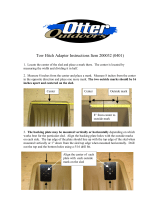
Contents
1 About your Dell PowerEdge FD332................................................................................................................ 5
Terms used in this document............................................................................................................................................5
Front panel features and indicators—PowerEdge FD332............................................................................................6
Storage sled status indicator...................................................................................................................................... 6
Hard drive/SSD indicators.................................................................................................................................................7
Storage Controller Module indicators.............................................................................................................................. 7
Documentation matrix....................................................................................................................................................... 8
Quick Resource Locator....................................................................................................................................................9
2 Performing initial system conguration........................................................................................................ 10
Setting up your PowerEdge FD332................................................................................................................................10
Managing your system remotely.....................................................................................................................................10
Downloading drivers and rmware..................................................................................................................................11
3 Storage sled mapping congurations............................................................................................................12
Single PERC/HBA Controller and joined mode mapping congurations...................................................................12
Split mode mapping congurations................................................................................................................................ 13
Split single host mapping conguration................................................................................................................... 14
Split dual host mapping conguration......................................................................................................................14
Drive to storage controller mapping.........................................................................................................................15
4 Installing and removing storage sled components......................................................................................... 17
Customer and eld replaceable units—PowerEdge FD332........................................................................................17
Safety instructions............................................................................................................................................................17
Before working inside your system.................................................................................................................................18
After working inside your system....................................................................................................................................18
Recommended tools.........................................................................................................................................................18
Storage sled.......................................................................................................................................................................18
Removing a storage sled............................................................................................................................................18
Installing a storage sled............................................................................................................................................. 20
Inside the sled...................................................................................................................................................................22
Drive drawer..................................................................................................................................................................... 22
Opening the drive drawer......................................................................................................................................... 23
Closing the drive drawer........................................................................................................................................... 24
Mini Enterprise Service Tag............................................................................................................................................25
Removing the Mini Enterprise Service Tag.............................................................................................................25
Installing the Mini Enterprise Service Tag............................................................................................................... 26
Hard drive/SSD assembly...............................................................................................................................................26
Removing a hard drive/SSD assembly....................................................................................................................26
Installing a hard drive/SSD assembly...................................................................................................................... 28
Removing a hard drive/SSD from the drive rails................................................................................................... 30
Installing a hard drive/SSD into the drive rails........................................................................................................ 31
Contents
3




















